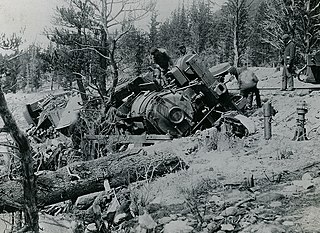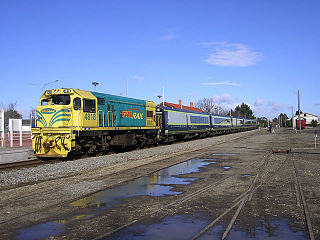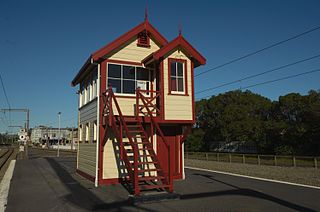
In rail transport, a derailment occurs when a rail vehicle such as a train comes off its rails. Although many derailments are minor, all result in temporary disruption of the proper operation of the railway system and they are a potentially serious hazard.

The New Zealand EM/ET class electric multiple units were used on suburban services in Wellington, New Zealand from 1982 to 2016. They were owned initially by the New Zealand Railways Corporation and finally by the Greater Wellington Regional Council (GWRC) and operated by Tranz Metro, part of national railway operator KiwiRail.

The Wairarapa Connection is a New Zealand interurban commuter rail service along the Wairarapa Line between Masterton, the largest town in the Wairarapa, and Wellington. It is operated by Wellington suburban operator Transdev under contract from the Greater Wellington Regional Council. It is a diesel-hauled carriage service, introduced by the New Zealand Railways Department in 1964 after passenger demand between Masterton to Wellington exceeded the capacity of the diesel railcars then used.

Metlink's Kapiti Line is the electrified southern portion of the North Island Main Trunk railway between New Zealand's capital city, Wellington, and Waikanae on the Kāpiti Coast, operated by Transdev Wellington on behalf of Greater Wellington Regional Council. Trains run frequently every day, with stops at 16 stations. Until 20 February 2011 it was known as the Paraparaumu Line.

Khandallah railway station is one of eight stations on the Johnsonville Line, a commuter branch railway north of Wellington in New Zealand’s North Island. The station was erected and operated by the Wellington and Manawatu Railway Company (WMR) on their line from Wellington to Longburn. From the acquisition of the WMR by the New Zealand Railways Department in 1908 until the opening of the Tawa Flat deviation in 1937, the station was on the North Island Main Trunk Railway.

The New Zealand FP/FT "Matangi" class is a class of electric multiple units used on the suburban rail network of New Zealand's capital city, Wellington. The class, consisting of an FP power car and an FT trailer car, operates services on all electrified lines of the network which comprise the Kapiti, Hutt Valley, Melling and Johnsonville lines. The units are owned by Greater Wellington Rail Ltd, a subsidiary of the Greater Wellington Regional Council (GWRC), and have been operated by Transdev Wellington under contract to the GWRC since 2016. They were previously operated by Tranz Metro, a former division of KiwiRail.
The Rimutaka incline railway line has had several accidents as the result of strong cross winds. On two occasions passenger trains were derailed by them. The first in 1880 resulting in four deaths, and the second in 1936 resulting in only injuries.

Paekakariki railway station in Paekākāriki on the Kāpiti Coast, New Zealand, is an intermediate station on the Kapiti Line for Metlink's electric multiple unit commuter trains from Wellington. Paekākāriki was the terminal station of the commuter service from 1940 to 1983, when the service was extended to Paraparaumu, and to Waikanae in 2011.

The Wellington and Manawatu Railway Company was a private railway company that built, owned and operated the Wellington-Manawatu railway line between Thorndon in Wellington, the capital of New Zealand, and Longburn, near Palmerston North in the Manawatu, between 1881 and 1908, when it was acquired by the New Zealand Government Railways. Its successful operation in private ownership was unusual for early railways in New Zealand.
This article lists significant fatal, injury-only, and other accidents involving railway rolling stock, including crashes, fires and other incidents in the Australian state of South Australia. The first known incident in this list occurred in 1873 in Smithfield, South Australia.
This is a list of significant railway accidents in Queensland, Australia.

The North–South Junction is a section of single-track rail line about 7 km long, north of Wellington, New Zealand between the closed (2011) Muri railway station and the (lower) Paekakariki railway station to the north. It is part of the Kapiti Line section of the North Island Main Trunk line between Wellington and Auckland, and part of the Wellington–Manawatu Line, built by the Wellington & Manawatu Railway Company (WMR).












